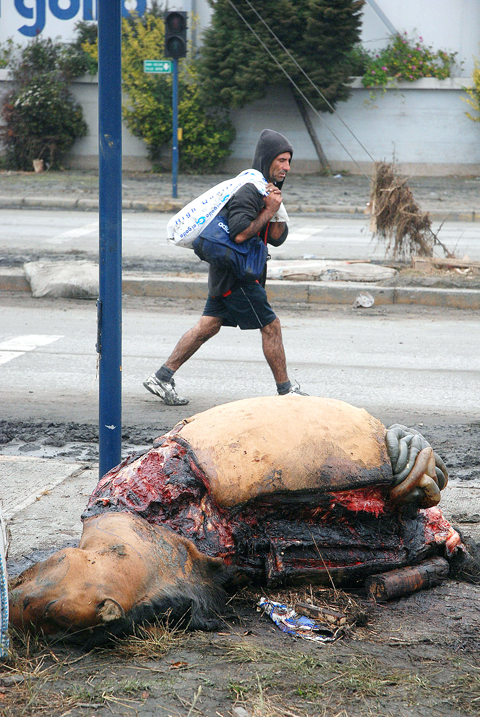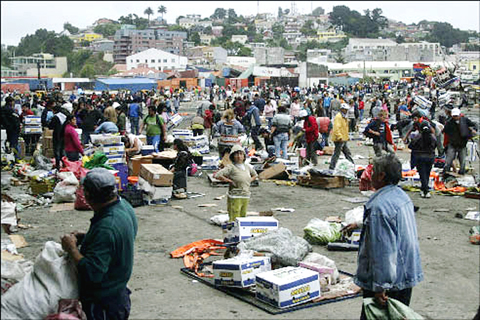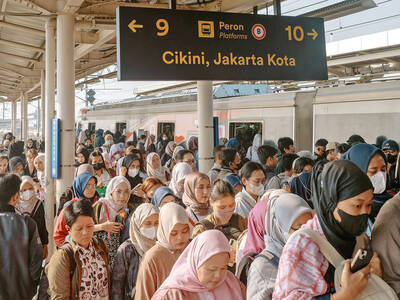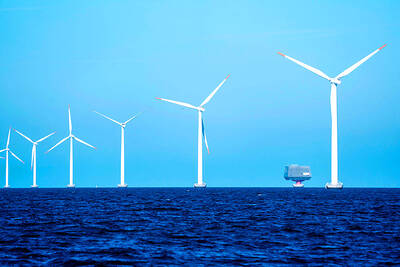The warning was ominous, its predictions dire — oceanographers issued a bulletin telling Hawaii and other Pacific islands that a killer wave was heading their way with terrifying force and that “urgent action should be taken to protect lives and property.”
The devastating tidal surge predicted after Chile’s magnitude 8.8 earthquake for areas far from the epicenter never materialized, however, and by Sunday, authorities had lifted the warning after waves half the predicted size tickled the shores of Hawaii and tourists once again jammed beaches and restaurants.
Scientists acknowledged they overstated the threat, but defended their actions, saying they took the proper steps and learned the lessons of the 2004 Indonesian tsunami that killed thousands of people who didn’t get enough warning.

PHOTO: AFP
“It’s a key point to remember that we cannot under-warn. Failure to warn is not an option for us,” said Dai Lin Wang, an oceanographer at the Pacific Tsunami Warning Center in Hawaii. “We cannot have a situation that we thought was no problem and then it’s devastating. That just cannot happen.”
Hundreds of thousands of people fled shorelines for higher ground on Saturday in a panic that circled the Pacific Rim after scientists warned 53 nations and territories that a tsunami had been generated by the massive Chilean quake.
It was the largest-scale evacuation in Hawaii in years, if not decades. Emergency sirens blared throughout the day, the Navy moved ships out of Pearl Harbor, and residents hoarded gasoline, food and water in anticipation of a major disaster. Some supermarkets even placed limits on items such as Spam because of panic buying.

PHOTO: EPA
At least five people were killed by the tsunami on Robinson Crusoe Island off Chile’s coast and huge waves devastated the port city of Talcahuano, near hard-hit Concepcion on Chile’s mainland.
The threat of monster waves that left Hawaii’s sun-drenched beaches empty for hours never appeared, however, a stark contrast to the tidal surge that killed 230,000 people around the Indian Ocean in 2004 and flattened entire communities.
This time, waves of more than 1.5m were reported in Kahului Bay in Maui and in Hilo, on the eastern coast of Hawaii’s Big Island, but did little damage. Predictions of wave height in some areas were off by as much as 50 percent.
In Tonga, where up to 50,000 people fled inland hours ahead of the tsunami, the National Disaster Office had reports of a wave of up to 2m hitting a small northern island, with no indications of damage.
In Japan, where authorities ordered 400,000 people out of coastal communities, the biggest wave was a 1.2m surge that hit the northern island of Hokkaido, flooding some piers.
After the Pacific Tsunami Warning Center lifted its warning, some countries kept their own watches in place as a precaution. Early yesterday, the Japan Meteorological Agency warned of a possible tsunami about 50cm in size along its entire Pacific coast and told people to stay away from the waterfront. That warning was cleared later yesterday morning.
Scientists offered no apologies for the warnings and defended their work, all the while worrying that the false alarm could lead to complacency among coastal residents — a disastrous possibility in the earthquake-prone Pacific Rim.
A similar quake in Chile in 1960 created a tsunami that killed about 140 people in Japan. The same surge hit Hawaii and devastated downtown Hilo, on the Big Island, killing 61 residents and wiping out more than 500 homes and businesses.
“If you give too many warnings and none of them materialize, then you lose your credibility,” Wang said. “That’s something that we have to deal with and we have to improve.”
Despite some of the panic in Hawaii, public officials called the evacuation “perfect” and said it was a good test case that proved the system worked.
Chaos was at a minimum as people heeded evacuation orders and roads were free of the gridlock that can paralyze a region before a disaster. The smooth response occurred largely because the state had so long to prepare; Hawaii is nearly 11,265km from where the quake hit and it took 15 hours for the tsunami to arrive.
“I hope everyone learned from this for next time, and there will be a next time,” said Gerard Fryer, a geophysicist for the warning center.

READINESS: According to a survey of 2,000 people, 86 percent of Swedes believe the country is worth defending in the event of a military attack Swedes are stocking up on food items in case of war, as more conflict in Europe no longer feels like a distant possibility, and authorities encourage measures to boost readiness. At a civil preparedness fair in southwest Stockholm, 71-year-old Sirkka Petrykowska said that she is taking the prospect of hostilities seriously and preparing as much as she can. “I have bought a camping stove. I have taken a course on preservation in an old-fashioned way, where you can preserve vegetables, meat and fruit that lasts for 30 years without a refrigerator,” Petrykowska said. “I’ve set aside blankets for warmth, I

FRUSTRATIONS: One in seven youths in China and Indonesia are unemployed, and many in the region are stuck in low-productivity jobs, the World Bank said Young people across Asia are struggling to find good jobs, with many stuck in low-productivity work that the World Bank said could strain social stability as frustrations fuel a global wave of youth-led protests. The bank highlighted a persistent gap between younger and more experienced workers across several Asian economies in a regional economic update released yesterday, noting that one in seven young people in China and Indonesia are unemployed. The share of people now vulnerable to falling into poverty is now larger than the middle class in most countries, it said. “The employment rate is generally high, but the young struggle to

ENERGY SHIFT: A report by Ember suggests it is possible for the world to wean off polluting sources of power, such as coal and gas, even as demand for electricity surges Worldwide solar and wind power generation has outpaced electricity demand this year, and for the first time on record, renewable energies combined generated more power than coal, a new analysis said. Global solar generation grew by a record 31 percent in the first half of the year, while wind generation grew 7.7 percent, according to the report by the energy think tank Ember, which was released after midnight yesterday. Solar and wind generation combined grew by more than 400 terawatt hours, which was more than the increase in overall global demand during the same period, it said. The findings suggest it is

‘ARMED CONFLICT’: At least 21 people have died in such US attacks, while experts say the summary killings are illegal even if they target confirmed narcotics traffickers US forces on Friday carried out a strike on an alleged drug-smuggling boat off the coast of Venezuela, killing four people, US Secretary of Defense Pete Hegseth said. The latest strike, which Hegseth announced in a post on X, brings the number of such US attacks to at least four, leaving at least 21 people dead. An accompanying video shared by Hegseth showed a boat speeding across the waves before being engulfed in smoke and flames. “Four male narco-terrorists aboard the vessel were killed,” the Pentagon chief wrote. He said the strike “was conducted in international waters just off the